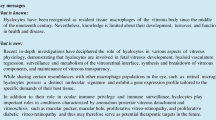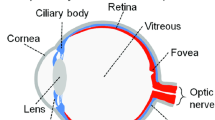Abstract
These experiments evaluate overexpression of basic fibroblast growth factor (FGF-2) as a treatment to decrease photoreceptor cell death in the constant light damage model of retinal degeneration. Increased FGF-2 expression was accomplished by gene transfer to the retina via injection into the subretinal space of a recombinant adeno-associated virus (rAAV), containing the FGF-2 gene. Rescue effects were assessed by morphometry and electroretinographic analysis.
Similar content being viewed by others
References
Noell WK, Walker VS, et al. Retinal damage by light in rats. Invest Ophthalmol 1966; 5(5): 450–73.
Faktorovich EG, Steinberg RH, et al. Basic fibroblast growth factor and local injury protect photoreceptors from light damage in the rat. J Neurosci 1992: 12(9): 3554–67.
LaVail MM, Unoki K, et al. Multiple growth factors, cytokines, and neurotrophins rescue photoreceptors from the damaging effects of constant light. Proc Natl Acad Sci USA 1992; 89(23): 11249–53.
Unoki K, LaVail MM. Protection of the rat retina from ischemic injury by brain-derived neurotrophic factor, ciliary neurotrophic factor, and basic fibroblast growth factor. Invest Ophthalmol Vis Sci 1994; 35(3): 907–15.
Masuda K, Watanabe I, et al. Functional Rescue of photoreceptors from the damaging effects of constant light by survival-promoting factors in the rat. Invest Ophthalmol Vis Sci 1995; 36(10): 2142–6.
LaVail MM, Yasumura D, et al. Protection of mouse photoreceptors by survival factors in retinal degenerations. Invest Ophthalmol Vis Sci 1998; 39(3): 592–602.
Liu C, Peng M, et al. Preconditioning with bright light evokes a protective response against light damage in the rat retina. J Neurosci 1998; 18(4): 1337–44.
Ranchon I, Gorrand JM, et al. Functional protection of photoreceptors from light-induced damage by dimethylthiourea and Ginkgo biloba extract. Invest Ophthalmol Vis Sci 1999; 40(6): 1191–9.
Wiegand RD, Giusto NM, et al. Evidence for rod outer segment lipid peroxidation following constant illumination of the rat retina. Invest Ophthalmol Vis Sci 1983; 24(10): 1433–5.
Akpalaba CO, AC Oraedu, et al. Biochemical studies on the effects of continuous light on the albino rat retina. Exp Eye Res 1986; 42(1): 1–9.
Lisman J, Fain G. Support for the equivalent light hypothesis for RP. Nat Med 1995; 1(12): 1254–5.
Lau D, McGee LH, et al. Retinal degeneration is slowed in transgenic rats by AAV-mediated delivery of FGF-2. Invest Ophthalmol Vis Sci 2000; 41(11): 3622–33.
LaVail MM, Gorrin GM, Repaci MA, Thomas LA, Ginsberg HM. Genetic regulation of light damage to photoreceptors Invest Ophthalmol Vis Sci 1987; 28: 1043–8.
Flannery JG, Zolotukhin S, et al. Efficient photoreceptortargeted gene expression in vivo by recombinant adeno associated virus. Proc Nat Acad Sci USA 1997; 94(13): 6916–21.
McGee Sanftner LH, Abel H, et al. Glial cell line derived neurotrophic factor delays photoreceptor degeneration in a transgenic rat model of retinitis pigmentosa. Mol Ther 2001; 4(6): 622–9.
McGee Sanftner LH, Rendahl KG, et al. Recombinant AAV-mediated delivery of a tet-inducible reporter gene to the rat retina. Mol Ther 2001; 3(5 Pt 1): 688–96.
Bachoud-Levi AC, Deglon N, et al. Neuroprotective gene therapy for Huntington's disease using a polymer encapsulated BHK cell line engineered to secrete human CNTF. Hum Gene Ther 2000; 11(12): 1723–9.
Aebischer P, Schluep M, et al. Intrathecal delivery of CNTF using encapsulated genetically modified xenogeneic cells in amyotrophic lateral sclerosis patients [published erratum appears in Nat Med 1996; 2(9): 1041. Nat Med 1996; 2(6): 696–9.
Mandel RJ, Spratt SK, et al. Midbrain injection of recombinant adeno-associated virus encoding rat glial cell line-derived neurotrophic factor protects nigral neurons in a progressive 6-hydroxydopamine-induced degeneration model of Parkinson's disease in rats. Proc Natl Acad Sci USA 1997; 94(25): 14083–8.
Bilang-Bleuel A, Revah F, et al. Intrastriatal injection of an adenoviral vector expressing glial-cell-line-derived neurotrophic factor prevents dopaminergic neuron degeneration and behavioral impairment in a rat model of Parkinson disease. Proc Natl Acad Sci USA 1997; 94(16): 8818–23.
Author information
Authors and Affiliations
Rights and permissions
About this article
Cite this article
Lau, D., Flannery, J. Viral-mediated FGF-2 treatment of the constant light damage model of photoreceptor degeneration. Doc Ophthalmol 106, 89–98 (2003). https://doi.org/10.1023/A:1022481306146
Issue Date:
DOI: https://doi.org/10.1023/A:1022481306146




